Why are my brakes squeaking?
How to fix brake squeaking
This article answers the question “Why are my brakes squeaking?” or Why are my brakes screeching?”The noise makes you wonder whether you have brake problems or brake issues. Brake screech can be cause by the pads and rotors, or by mechanical contact between the rotor and a mechanical component. So I’ll explain how to fix noisy brakes. Here’s how to diagnose the issue.
#1 Cause of brake screech or brake squeal
Brake screech is cause by vibration. Think of the rotor as an LP record and the pad itself as a turntable stylus. The pad rides in the microscopic grooves on the rotor and the pad vibrates. The brake pad backing plate is in contact with the caliper and the backing plate steel-to-caliper contact is what “plays” the music. In this case the music is a screeching noise.
Fix noisy brakes and brake screech
Car makers utilize noise reduction shims to dampen the vibrations
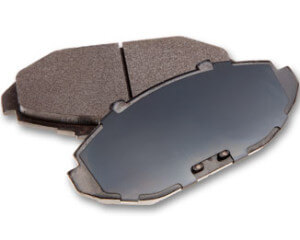
Brake pad with noise reduction shim attached
between the brake pad backing plate and the caliper. If you’ve had a brake job or done a brake job yourself and you didn’t replace the noise reduction shims with new ones, that alone can cause brake screech and brake squeal. Sometimes, all it takes is new noise reduction shims to stop the brake squeal and brake screech.
Next, many car makers recommend an application of high temperature brake grease between the brake pad backing plate and the areas where the backing plate contacts the caliper. The purpose of the grease is to dampen vibrations. The grease can be plain high temperature synthetic (silicone), high temperature synthetic with embedded ceramic particles, or molybdenum. Apply this grease as a light film only. Apply to only those areas of the backing plate that contact the caliper.
#2 Cause of brake screech or brake squeal
Most car makers utilize anti-rattle clips to hold the pads in the caliper or abutment area. These anti-rattle clips are made from stainless steel to prevent rust.
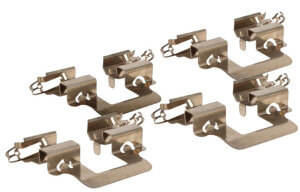
Anti-rattle clips
Many DIYers and some shops simply reuse these clips during a brake job. Bad idea! These clips can rust over time and high heat can cause them to lose their tension. The job of the anti-rattle clip is to apply some pressure to the ears of the brake pad to reduce vibration. High quality brake pads come with new anti-rattle clips. But economy pads don’t. If you haven’t installed new clips and now encounter brake squeal or brake screech, install new anti-rattle clips.
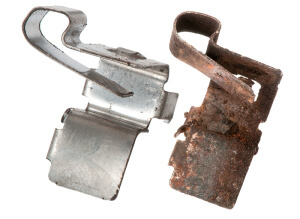
High heat degrades the spring tension of the anti-rattle clips and rust can cause the brake pad “ears” to bind
Fix noisy brakes and brake screech
Anti-rattle clips install on the caliper or the brake abutment. Corrosion under the clips can cause the clips to bind the brake pad ears and cause uneven pad wear and generate brake squeal and brake screech. Remove the old anti-rattle clips and clean all rust off the clip mounting surface. Then apply a very light coat of high temperature brake grease to the mounting surface UNDER the anti-rattle clip. The synthetic grease will slow down rust formation and reduce the “rust jacking” effect of rust buildup.
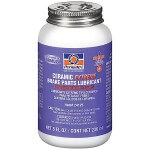
High temperature ceramic brake grease
Some shops also apply high temperature brake grease to the area where the pad sits in the clip, thinking that the grease will allow the pad to slide easier. That part is true. But if the clip is new, the pad will slide without the aid of grease. And, a new clip will apply enough pressure to the pad ear to prevent it from vibrating and causing brake squeal or brake screech. The downside to applying grease is that it picks up road dirt and brake dust.
If the brake screech or brake squeal continues, you can apply an
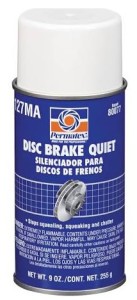
Anti-squeal compound
anti-squeal spray or anti-squeal compound to the backing plate. These products dry to a rubbery consistency to further dampen the vibrations.
#3 Cause of brake squeal
I often see forum posts asking why the owner’s brakes screech only when turning in one direction. This can be caused by two items; a bent brake dust shield
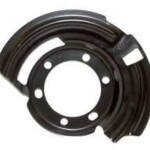
Typical brake dust shield. Also called a splash shield
or worn wheel bearings. The job of the dust shield is to catch airflow from a moving vehicle and blow any brake dust or road debris away from the pad and rotor. The shield also prevents road debris from splashing against the pad/rotor. But the dust shield is easily bent during a brake job or from contacting snow.
If the dust shield is bent towards the rotor, it can cause a high pitched metallic brake screech sound all the time or only when turning the wheels in one direction. For example, if you hear brake screech when turning left, it may be caused by a bent dust shield that is being forced against the rotor by the airflow induced during a left turn. When turning right, the same brake shield isn’t exposed to the same airflow.
The brake dust shield is held in place by several screws or rivets. Over time these fasteners can rust and the shield can break loose. You can buy a new dust shield online for from the dealer. Replace a broken shield with new stainless steel screws and nuts fastened with thread locker.
A worn wheel bearing, can cause the brake noise
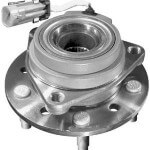
Wheel bearing hub assembly
The worn bearing can cause the rotor to tilt slightly during a turn. The brake caliper is attached to the steering knuckle, so it stays in the same location while the rotor tilts.
Fix noisy brakes and brake screech
A brake dust shield is made from stamped sheet metal. It’s easily bent and can be bent back out of the way without any special tools. Just grab it and bent it away from the rotor.
To check for a worn wheel bearing, raise the vehicle and wiggle the wheel, holding it at the 9:00 and 3:00 position. You should not feel any movement. Then repeat by wiggling the wheel at the 12:00 and 6:00 position.
©, 2014 Rick Muscoplat
Posted on by Rick Muscoplat